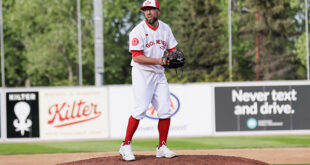The Whiz Kids had won it,
Bobby Thomson had done it,
And Yogi read the comics all the while.
Those of us old enough to have lived through the 1981 baseball players’ strike (and, later the ‘94 lockout) remember how severely it damaged the fans’ connection with the sport, which may have already been passed in popularity by football and was on the verge of a huge challenge from the NBA. Directed mostly at players though more properly deserved by owners, fans’ vitriol was palpable, even when the season resumed in August.
And while it took years to approach undoing the damage—some feel it’s never been completely repaired—the game did survive, and right in the middle of the redemption was a song that wasn’t even the A-side of the single when it was released in February 1981.
We speak of “Talkin’ Baseball,” familiarly known as the “Willie, Mickey and the Duke” song, which debuted before that fateful season. Written, performed and produced by Terry Cashman, it was an instant hit that has only grown in stature over time, and, as many like Bill Madden in the current issue of Baseball Digest argue, went a long way to helping fans reconcile with the sport that had broken their collective hearts.
We’re talkin’ baseball!
Kluszewski, Campanella.
Talkin’ baseball!
The Man and Bobby Feller.
“Once the strike hit, [‘Talkin’ Baseball’] became more popular and had a second life because the song related to the 50s and a perceived innocent time in baseball,” Cashman told SportsMedia Report by telephone from New York. “The players mentioned in the song were thought of as guys who just loved baseball. It wasn’t true but it’s what [fans] related to.”
The origin of the song is a mix of fortunate timing and a match between a successful record production team that released albums from the likes of Jim Croce and happened to love baseball.
“[Partners Tommy West and Gene Pistelli] and I felt it was a good time for a baseball song. Someone came to us with a baseball song, and in those days you put them out as singles,” Cashman explained. “Of course, if we were going to release this particular song, we needed a ‘B’ side. All of a sudden, it occurred to me that I had a picture of Willie, Mickey, Duke Snider and Joe DiMaggio from an Old Timer’s Day at Shea Stadium.
“Well that picture stirred something in my brain,” he continued, “and after I realized that DiMaggio had retired in 1951 just as Willie Mays and Mickey Mantle came up and Duke Snider was just younger it hit me, that was the song. And the ‘Talkin’ Baseball’ part was my recollection of all those nights on the corner waiting for newspapers when baseball was all the talk. All those arguments of who was better: Ted Williams or Stan Musial; Yogi [Berra] or [Roy] Campanella; and especially Willie, Mickey and the Duke.”
I’m talkin’ baseball!
Like Reggie, Quisenberry.
Talkin’ baseball!
Carew and Gaylord Perry,
Seaver, Garvey, Schmidt and Vida Blue
Connecting those players to the 1981 audience wasn’t as much of a challenge, says Cashman, as it might seem today, with four more decades gone by and names like Sal Maglie, Ted Kluszewski and Don Newcombe not as well known to fans today. Versions of the song for every team, spurred by a Mariners executive first wanting a few then-current players added to a specialized singing at the Kingdome as play resumed, kept interest high among all fandoms.
“The teams with great histories were easiest to do, like the Yankees, Cardinals,” said Cashman of the team-specific lyrics. “The teams that moved around, the Giants, the A’s, they were harder, they wanted the players from their cities not the previous ones. But I think they all came out pretty good.”
Talkin’ softball,
Mattingly and Canseco,
Ken Griffey’s grotesquely swollen jaw,
Steve Sax and his run-in with the law,
We’re talkin’ Homer,
Ozzie and the Straw.
Then, of course there is the variation that aired during the third season of “The Simpsons” in 1992, in one of the animated series’ most popular and enduring episodes, “Homer at the Bat.” Utilizing key plot points, the song highlighted numerous hugely popular players, and though Cashman says that he didn’t write most of the lyrics, he did perform the parody that he adds “brought a whole new audience, including young kids, to the song.”
At 80, Cashman doesn’t attend many games these days, noting that two-hour exits from the parking lot leave something to be desired. But having heard the song played at games in the past, Cashman takes a sense of pride in helping parents and children connect in the context of baseball.
“I remember one time in particular, it really brought tears to my eyes,” he recalled. “A father and son were singing along sitting in front of me and they of course didn’t know that I was there. The father started saying, ‘you know who he was, Kluszewski, and Bob Feller.’ The whole idea that here he was, passing it on through the song.”
Read more about the circumstances around ‘Talkin’ Baseball’ in its 40th anniversary season in the current issue of ‘Baseball Digest.’
 Sports Media Report
Sports Media Report


